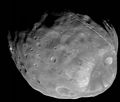চিত্ৰ:Phobos colour 2008.jpg

এই খচৰাৰ আকাৰ: 636 × 600 পিক্সেল. আন ৰিজ'লিউশ্যনসমূহ: 255 × 240 পিক্সেল | 509 × 480 পিক্সেল | 815 × 768 পিক্সেল | 1,086 × 1,024 পিক্সেল | 2,172 × 2,048 পিক্সেল | 3,500 × 3,300 পিক্সেল।
মূল ফাইল (3,500 × 3,300 পিক্সেল, ফাইলৰ মাত্ৰা: 2.72 MB, MIME প্ৰকাৰ: image/jpeg)
ফাইলৰ ইতিবৃত্ত
ফাইলৰ আগৰ অৱস্থা চাবলৈ সেই তাৰিখ/সময়ত ক্লিক কৰক।
| তাৰিখ/সময় | ক্ষুদ্ৰ প্ৰতিকৃতি | আকাৰ | সদস্য | মন্তব্য | |
|---|---|---|---|---|---|
| বৰ্তমান | 03:10, 2 April 2018 |  | 3,500 × 3,300 (2.72 MB) | Kaldari | more margin on right side |
| 04:47, 13 November 2008 |  | 3,374 × 3,300 (2.7 MB) | Fir0002 | == Summary == {{Information |Description=Colour image of Phobos, imaged by the Mars Reconnaisance Orbiter in 2008 |Source=NASA |Date=9 April 2008 |Location=http://www.nasa.gov/mission_pages/MRO/multimedia/pia10368.html |Author=NASA/J |
ফাইল ব্যৱহাৰ
তলত দিয়া 3 পৃষ্ঠাবোৰে এই ফাইলটো ব্যৱহাৰ কৰে:
ফাইলৰ গোলকীয় ব্যৱহাৰ
তলত দিয়া আন ৱিকিসমূহে এই ফাইলটো ব্যৱহাৰ কৰে:
- af.wikipedia.org-ৰ ব্যৱহাৰ
- an.wikipedia.org-ৰ ব্যৱহাৰ
- ar.wikipedia.org-ৰ ব্যৱহাৰ
- المريخ
- فوبوس
- قمرا المريخ
- ويكيبيديا:صور مختارة/الفضاء والكون/نظرة إلى الأعلى
- قائمة أجرام المجموعة الشمسية مرتبة حسب الحجم
- بوابة:علم الفلك/صورة مختارة
- بوابة:المريخ
- بوابة:المريخ/مقالة مختارة/أرشيف
- بوابة:المريخ/مقالة مختارة/2
- قائمة الأقمار الطبيعية
- خط زمني لاكتشاف كواكب المجموعة الشمسية وأقمارها
- ويكيبيديا:ترشيحات الصور المختارة/القمر فوبوس
- ويكيبيديا:صورة اليوم المختارة/أغسطس 2019
- قالب:صورة اليوم المختارة/2019-08-03
- بوابة:علم الفلك/صورة مختارة/73
- معسكر قاعدة المريخ
- ويكيبيديا:صورة اليوم المختارة/يناير 2022
- قالب:صورة اليوم المختارة/2022-01-04
- ary.wikipedia.org-ৰ ব্যৱহাৰ
- arz.wikipedia.org-ৰ ব্যৱহাৰ
- azb.wikipedia.org-ৰ ব্যৱহাৰ
- az.wikipedia.org-ৰ ব্যৱহাৰ
- be-tarask.wikipedia.org-ৰ ব্যৱহাৰ
- be.wikipedia.org-ৰ ব্যৱহাৰ
- bg.wikipedia.org-ৰ ব্যৱহাৰ
- bh.wikipedia.org-ৰ ব্যৱহাৰ
- bn.wikipedia.org-ৰ ব্যৱহাৰ
- bn.wikibooks.org-ৰ ব্যৱহাৰ
- bs.wikipedia.org-ৰ ব্যৱহাৰ
- ca.wikipedia.org-ৰ ব্যৱহাৰ
এই ফাইলটোৰ অধিক গোলকীয় ব্যৱহাৰ চাওক।




